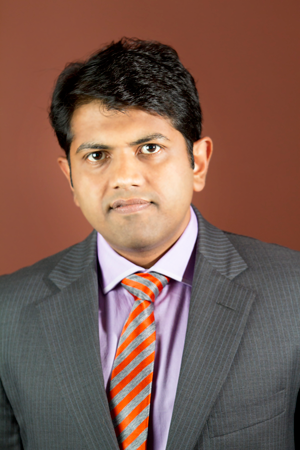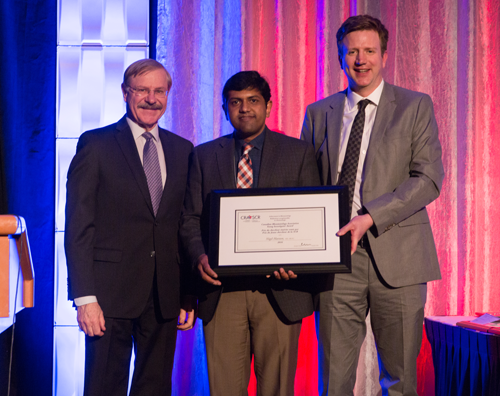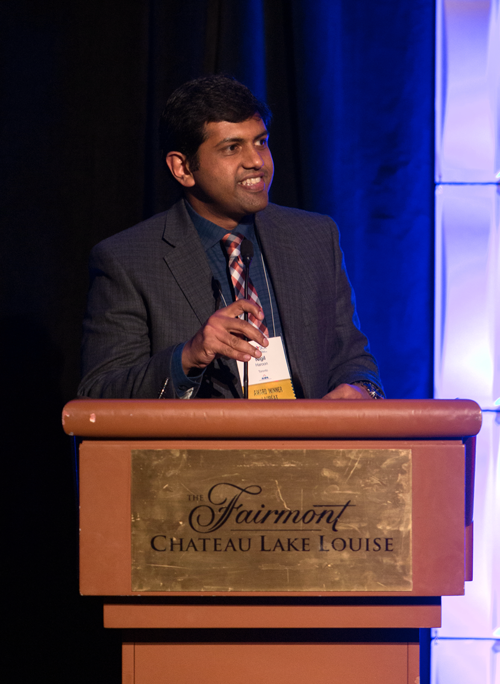Summer 2016 (Volume 26, Number 2)
Young Investigator:
Dr. Nigil Haroon
Download PDF

You have collected some serious CRA hardware over the years, with wins for best abstract, paper, basic science research, and now, the Young Investigator Award. How has the CRA shaped your career trajectory?
National level recognitions are a benchmark of success used in peer review for promotions, grants, career awards, etc. The CRA has provided a platform for young investigators to present their work, get important feedback, and be recognized. I feel the CRA has contributed immensely not only to my career, but to those of several young rheumatologists across the country. It is extremely gratifying to see so many well-wishers from your family.
Your success in obtaining research funding is commendable, with over one million dollars as a principal investigator in addition to being co-principal investigator in other grants. Any tips you can offer on the subject of making a solid grant proposal?
I had a big advantage of coming into practice with experience writing grants. During my research training with
Dr. Robert Inman, I contributed to writing several grants and this gave me a feel for the language, content, and presentation style needed to write a successful grant. I still do not feel I have aced it, but it is a good start!
You keep improving with not only writing more but with the amount of preliminary data you have generated,
the number of collaborators in your group, and the
evidence of productivity and success.
Are you a morning or night person?
Both. And not much in between, sadly.
Why did you decide to focus
your investigations into spondyloarthritis? What connections have you seen between ankylosing spondylitis (AS) and the broader field of rheumatic diseases?
My fascination for immunology led me to rheumatology. There were several avenues I explored, including looking at predicting methotrexate efficacy in rheumatoid arthritis (RA) patients using a baseline ex vivo assay that was published in the Journal of Rheumatology (JRheum) during my residency. After joining
Dr. Inman’s, lab it was natural to work in AS and HLA-B27-related pathogenesis particularly interested me. Is it not amazing that even after
40 years of research we still do not know the pathogenic role of HLA-B27 in AS? 
Dr. Haroon receiving his latest award from Dr. Inman and Dr. Cory Baillie.
Are there other areas of interest you would like to investigate in the future? What projects will you be undertaking this year?
I am working on the unknown links between inflammation and new bone formation in AS. We have some pretty
exciting leads that my post-doctoral fellow, Dr. Vidya Ranganathan, is working on. In my lab, Dr. Michael Zeng is working on intracellula trafficking abnormalities and their link to AS.
What was your first thought when you learned that you would receive this award?
Thanks for all the blessings.
Over the course of your life, how many cities have you lived in and which was your favorite?
I have lived in eight cities, and Toronto is definitely my favourite.
You were the lead author on a landmark study that noted patients with AS have increased cardiovascular and cerebro-vascular mortality. The paper significantly changed the narrative around comorbidities in AS and may transform clinical care in this disease. What was the tipping point in that research, and when did you know you were on to something big?
The data were quite impressive and the sheer number of patients that we were able to study, thanks to the Ontario health administrative datasets, was a huge advantage. Our data was validated to an extent by expected observations, including the high prevalence of inflammatory bowel disease (IBD) in AS patients as well as the cardioprotective effects of statin use in cardiovascular disease. The 90% reduction in risk of cardiac events with nonsteroidal anti-inflammatory drug (NSAID) use was exciting and honestly, not a total surprise. This finding was extremely important as it corroborated previous reports of decreased mortality with NSAIDs in RA patients.
If you could be any joint in the body, which would
you be and why?
The temporomandibular joint (TMJ): I could keep
eating!
What talent do you have that is not utilized successfully in your workplace?
Leadership.

A true highlight in one’s career.
You were one of only four non-American rheumatologists invited to co-author the recently published American College of Rheumatology (ACR) guidelines for the management of spondyloarthritis. What was your experience in working with this prestigious international collective? Was there anything you took away from the experience that will guide your own authorship practices?
It was a great experience to work with a team of experts. Productivity and quality of work is high when you have teams built around individuals with complimentary expertise. The intensity and level of commitment
needed to complete the Grading of Recommendations Assessment, Development and. Evaluation (GRADE) process is just unbelievable until you have actually
experienced it.
If you had a "theme song" that played whenever you enter a room full of people, what song would it be?
The Final Countdown. But no escalators, please.
Our sources tell us you are also an accomplished nature photographer. How do you see the interplay between your art and your research?
Research is intense and balancing the life of a clinician and that of a scientist is extremely important. Often the days are long and the nights sleepless. The level of stress can—at times—peak and you need a vent. Photography
is mine. I tend to forget everything when I see the world through my lens. Those are my private moments of
meditation. It keeps me sane.
If you had one free hour each day, how would you
use it?
Catching up!
What has been your proudest accomplishment in your research to date?
Receiving the CRA Young Investigator Award.
For those wanting to pursue rheumatology and a career in research, what is your advice?
Go for it. The sky is the limit. There is not a dull day in the life of a clinician scientist.
Nigil Haroon, MD, PhD, DM
Assistant Professor of Medicine and Rheumatology,
University of Toronto
Clinician Scientist,
University Health Network
Scientist,
Krembil Research Institute
Toronto, Ontario |



